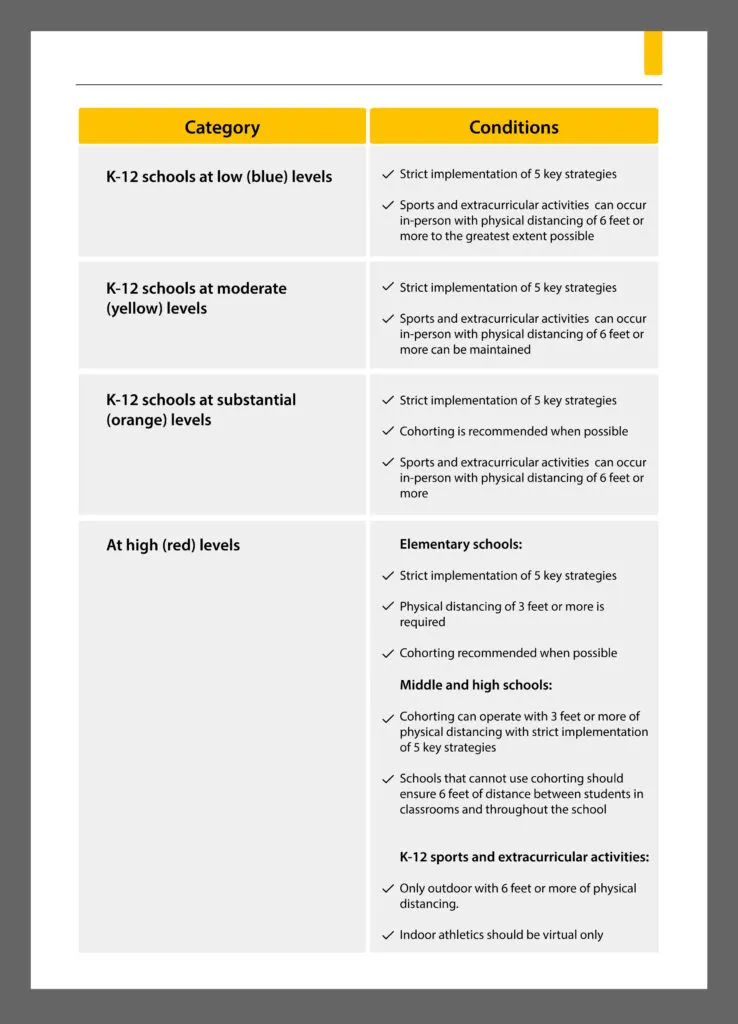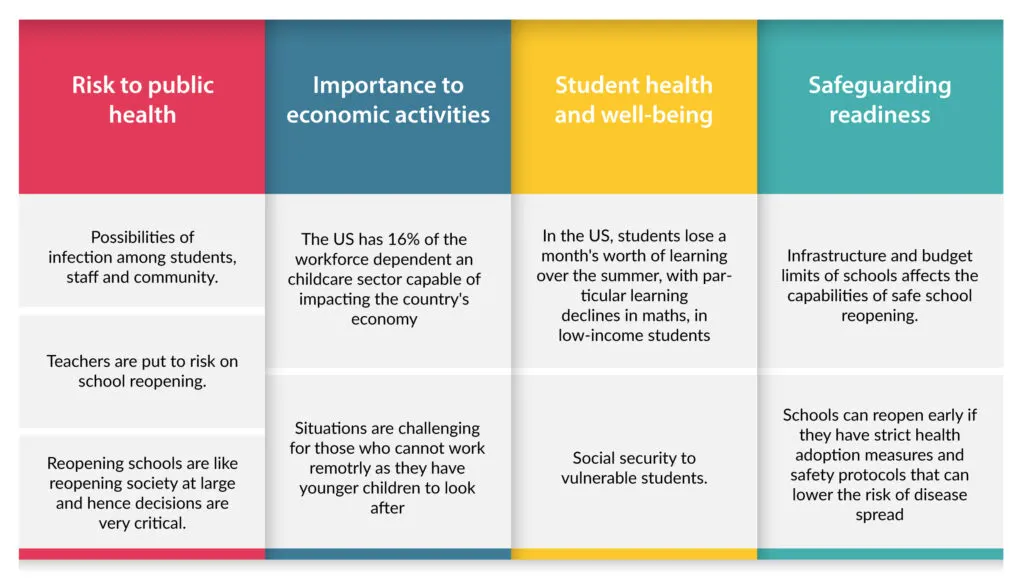Several school districts in the US have been shuttered for more than a year and are struggling with how to open schools safely. The stakes are massive. With coronavirus rates still high and more variants of the virus emerging, schools, parents and children are equally concerned about school reopening safety.

In February, President Joe Biden issued the set of COVID-19 prevention guidelines as proposed by the Centers for Disease Control and Prevention (CDC) for safely reopening schools. The guideline deliberates important points of safe K-12 school operations for in-person learning.
The President also emphasized that the price of protecting children, families, and educators is nothing when compared with the price of failure to act. He added that mental well-being and educational disproportions due to remote learning are growing concerns of the country and this is one of the reasons why schools need to reopen under stringent settings.
Safety measures should schools adopt on reopening
The CDC has recommended school districts to ensure 5 key prevention strategy namely for school reopening viz.:
- Universal and correct wearing of masks
- Physical distancing
- Handwashing and respiratory etiquette
- Cleaning and maintaining healthy facilities including ventilation improvements
- Contact tracing in combination with isolation and quarantine.
The following guidelines were also issued to ensure safety while reopening:
1. Community data assessment
To determine whether school districts should proceed with in-person learning, it is important to analyze the data of community-level transmission. The CDC K-12 operational strategy has recommendations about threshold of community transmissions, based on which schools should take associated actions to reopen school safely.
CDC has pointed out 4 categories of COVID-19 community transmissions:
1. Low (blue)
2. Moderate (yellow)
3. Substantial (orange)
4. High (red)
These categories are derived from metrics such as total new cases/100000 persons in one week and rate of positive diagnostic and screening viral tests that are NAATs and RT-PCR tests.
On the basis of these thresholds, school districts can take the first step towards implementation strategy:

2. Require universal masking:
Encourage universal and correct wearing of masks that provide necessary protection. Students and staffs preferring in-person learning should know how to correctly wear disposable/cloth masks. Schools should determine how to best support staff and students (including the narrow subset of students with disabilities) who cannot correctly wear masks.
3. Use of school space
Ensure classroom layouts have sufficient safe space for physical distancing. School administration has to conduct school walk-throughs for identifying spaces where additional changes are to be made. Schools can identify and utilize safe spaces in their community like libraries and community recreational centers to follow the instruction regarding maintaining physical distancing. Extra planning time should be provided to schools for redesigning classrooms and familiarizing new routines among staff to support physical distancing.
4. Use healthcare tools that lets you stay compliant to DOH directives and privacy laws
Using healthcare management software that are FERPA and HIPAA compliant, which also lets you collaborate with public health departments can help you meet diagnostic testing, communication and tracking needs – which are critical as school reopen. When school staff or students test positive, it is important to quickly coordinate with all important touchpoints like parents, healthcare providers, health departments and so on to ensure impact is low and school functions go undisrupted. In situations as such, a school nurse EHR software like EduHealth with contact tracing features can be beneficial for you.
5. Facility improvement:
Ensuring proper ventilation, open windows, and doors, using fans where safe and feasible, consistent cleaning of the facility, auditing existing ventilation systems, and improving ventilation wherever necessary are all part of the facility improvement plan. There should be frequent checkpoints to ensure timely changing of ventilation filters and ensuring proper air circulation. Good ventilation is one key to control a virus known to be airborne
6. Sports, events, and extracurricular activities
The format of additional school activities should strictly adhere to the CDC guidelines and events that require close contact between competitors pose a high risk than others – it is best not to conduct such events. Other events that involve the least physical contact can be played outdoors with strict adherence to physical distancing guidelines.
Transmission of COVID-19 among students: What we know
The transmission of COVID-19 among students is substantially lower when compared with community-wide spread, according to CDC. Other studies also revealed that in controlled environments like schools, transmission rates are lower compared with community levels.
The CDC also pointed out that one of the school districts in North Carolina held in-person learning and adhered to strict mitigation measures like wearing masks and social distancing. It was noted that the transmission rate in this school district was low, even when community transmissions were at high rates.
On analyzing the school-based transmission rates, experts say that transmissions were more common in adults than in children. The COVID-19 infected children were asymptomatic and possessed high risks of spreading the disease to parents and grandparents. However, shreds of evidence suggest that children under the age of 10 transmit it less efficiently than children of 10+ age.
Should schools reopen?
According to UNESCO, the lockdown led to partial or full closure of schools, affecting more than 90% of the student population across 186 countries around the world. In USA, the Biden administration is apprehensive about the negative consequences of remote learning like forfeited academics and mental struggles of children.
During the onset of the pandemic, it was assumed that children are susceptible to get infected and were likely vectors of disease spread. However, there is very little evidence on transmission in schools, outside of indoor practices and competition events. Only 3.7% of Covid-19 cases in students resulted from the in-school transmission. This is backing the decisions of those in favor of in-person schooling.
On top of this, parents are having a tough time managing kids at home while working. 20% of full-time employed parents have a child younger than 9 at home, of which 61% have no spouse or a full-time working spouse. This points to the fact that while parents’ reasons for opening schools stand strong on one side, their anxieties of community transmissions through children stand even stronger on the other.
Another survey conducted by Statista in February 2021 in the US indicated some interesting information. Of the surveyed parents, 31% was favoring remote learning only, while 26% said that the schools should be completely reopened. Assessing different responses and societal conditions, one thing is for sure: we cannot have “yes” or “no” as an answer to the question asked: “Should schools reopen?”
All these lead us to the following public, economic, individual and security parameters with respect to school reopening:

When should schools reopen?
Amid COVID-19 concerns, teachers in Chicago and Arkansas are refusing in-person classes. As susceptibility to severe COVID-19 illness is closely related to age, the reluctance of teachers towards in-person learning is reasonable. The median age of American teachers is 41.8 and less than a fifth are aged more than 55. Owing to these matters, outlooks on reopening schools are varying from district to district and state to state.
Approximately 75% of school districts in the US are conducting learning in the online mode only, alongside states including Washington DC advocating remote learning for the rest of the academic year. Those who have fully reopened for in-person learning average to only less than one in five.
Schools aren’t sure if they should reopen, and parents aren’t sure if they should send their wards to schools. Things are still unclear and for the time being, it is best to assume that the schools will reopen once situations turn most favorable.
For which segments of students and teachers should schools reopen?
Some school districts find reopening schools as a risky option as they are struggling to develop workable reopening plans. However, the hybrid system is passable for some school districts as they could use it as a way to ensure 6 feet of physical distancing between students and teachers.
Hybrid programs are most preferred in many countries as a compromise between fully remote and fully in-person learning. But, teachers are finding it difficult to manage students in the school and students connecting from home at the same time.
By and large, in-person learning is safer for elementary schools. One reason for this is the ease of managing students through cohorts, wherein they come in contact with a limited number of people. Besides, young children are supposed to transmit the virus less efficiently, reducing the risk of an outbreak.
Schools can also adopt powerful tracking technology to keep their schools open and safe for students. Tracking technology like the COVID 19 tracker module on EduHealth can help in identifying symptoms of an illness in children early on and will enable school nurses to redirect the students to the appropriate healthcare professionals. These practices go a great way in ensuring safe school functioning once schools reopen.








